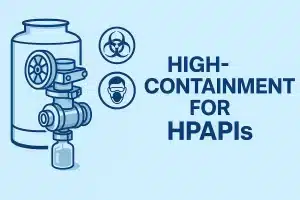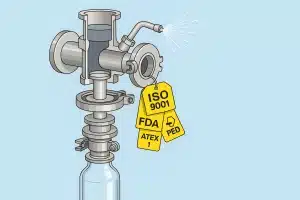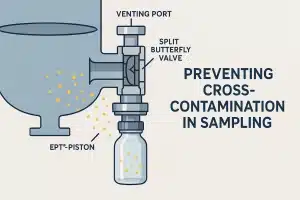In the intricate world of industrial processing, the purity and quality of products are paramount. Sanitary sample valves play a crucial role in ensuring that the samples drawn from various stages of production are contaminant-free and reflective of the overall process. From the pharmaceutical industry to food and beverage manufacturing, these valves are indispensable tools that enable precise quality control and assurance.
What is a Sanitary Sample Valve and How Does it Work?
Understanding the Purpose of a Sanitary Sample Valve
A sanitary sample valve is a specialized valve designed to extract samples from a larger body of fluid within a production system. It is primarily used in industries where purity and cleanliness are essential, such as pharmaceuticals, food, and beverages. The valve’s purpose is to allow operators to take a high-quality sample without introducing contaminants that could compromise the integrity of the product. These valves are used to monitor quality and consistency, ensuring that the production process meets industry standards.
How Does a Sanitary Sample Valve Ensure Purity?
Sanitary sample valves are engineered to ensure purity through their design and materials. Typically made from stainless steel, they offer excellent resistance to corrosion and facilitate a sterile environment. The valve’s design minimizes dead space where microbes could thrive and contaminate the sample. When the valve is opened, its sealing mechanisms, such as diaphragms and valve seats, prevent contamination from external sources, maintaining the purity of the sample taken. The high-quality sample is then used for various analyses, ensuring the product’s compliance with safety standards.
Common Applications in the Industry
Sanitary sample valves find applications across a range of industries, including pharmaceuticals, food and beverage, and chemicals. In the beverage industry, for example, they are used to sample liquids like soda and soft drinks to ensure consistency in flavor and quality. Similarly, in pharmaceutical manufacturing, these valves are crucial for sampling during drug production to ensure that the chemical composition meets stringent health regulations. Moreover, in the chemical industry, they help in sampling fluids from reactors and processing tanks, ensuring that the desired chemical reactions occur without contamination.
Why is Stainless Steel Preferred in Sanitary Sample Valves?
The Advantages of Using Stainless Steel
Stainless steel is the material of choice for sanitary sample valves due to its numerous advantages. It is highly durable, resistant to corrosion, and capable of withstanding the harsh conditions often found in industrial environments. Stainless steel’s non-reactive nature ensures that it does not affect the purity of the sample. Additionally, its smooth surface and hygienic properties mean that it is easy to clean and maintain, minimizing the risk of contamination. These properties make stainless steel an ideal material for valves used in industries where high-quality sample integrity is critical.
Types of Stainless Steel Used in Valve Manufacturing
In valve manufacturing, several types of stainless steel are employed, each tailored for specific applications. Commonly used grades include 304 and 316 stainless steel. Type 304 is known for its good corrosion resistance and is suitable for general applications. Type 316, on the other hand, contains molybdenum, which enhances its resistance to chlorides and other corrosive substances, making it ideal for more demanding environments such as chlorine removal towers. The choice of stainless steel type is determined by the valve’s intended application and the specific requirements of the industry.
Comparing Stainless Steel with Other Materials
When compared to other materials like plastic or brass, stainless steel stands out for its superior strength, longevity, and resistance to extreme temperatures and chemicals. While plastic valves may be suitable for certain low-demand applications, they often lack the durability and reliability required for critical processes. Brass, although durable, can corrode over time when exposed to certain chemicals. In contrast, stainless steel offers a dependable solution that combines strength with the ability to maintain a sterile environment, crucial for industries that prioritize hygiene and purity.
How Do Sanitary Sample Valves Prevent Contamination?
Design Features that Ensure a Contamination-Free Process
Sanitary sample valves are designed with features that prevent contamination. These include a polished interior surface that reduces the likelihood of residue buildup, and a streamlined configuration that eliminates dead space where contaminants could accumulate. The valve’s design allows for easy disassembly and cleaning, ensuring that no contaminants remain trapped within the valve, which could otherwise compromise the sample’s purity. By incorporating these features, sanitary sample valves provide a reliable means of obtaining uncontaminated samples.
Sealing Mechanisms in Sanitary Sample Valves
The sealing mechanisms in sanitary sample valves play a vital role in preventing contamination. A common type of seal used is the diaphragm seal, which acts as a barrier between the sample and the external environment. This seal ensures that only the sample passes through when the valve is opened, maintaining sterility. Other sealing options include O-rings and gaskets made from materials compatible with the fluid being sampled, further enhancing the valve’s ability to prevent contamination and ensure the purity of the water used or any other liquid.
Maintenance Tips to Avoid Contamination
Regular maintenance is essential to ensure that sanitary sample valves function correctly and remain free of contamination. Operators should routinely inspect valves for wear and tear, particularly focusing on seals and moving parts. Cleaning the valve thoroughly after each use is crucial to prevent residue buildup. Additionally, following the manufacturer’s guidelines for maintenance and using appropriate cleaning agents will help maintain the valve’s integrity and extend its lifespan. Proper maintenance practices not only ensure the valve’s performance but also safeguard the quality of the samples taken.
What are the Technical Specifications of Top-Flo® SV2 and EV2 Valves?
Overview of Top-Flo® SV2 and EV2 Valves
Top-Flo® SV2 and EV2 valves are renowned for their reliability and performance in sanitary applications. These valves are designed to provide precise control and sampling capabilities in demanding environments. The SV2 model is particularly noted for its robust construction and ease of use, while the EV2 model offers advanced features such as in-line measurement capabilities, which enable real-time analysis of the sampled fluid. Both models exemplify the high standards required for sanitary sample valves in various industries.
Technical Specifications to Consider
When selecting a sanitary sample valve, understanding the technical specifications is crucial. For Top-Flo® SV2 and EV2 valves, factors such as the valve’s size, type of connection, and pressure rating must be considered. These specifications determine the valve’s compatibility with existing systems and its ability to handle the required flow rates and pressures. Additionally, the choice between manual and automated operation can impact the valve’s functionality and ease of use in a production line.
In-Line Measurement Capabilities
In-line measurement capabilities are an innovative feature offered by some sanitary sample valves, including the Top-Flo® EV2. This feature allows operators to conduct real-time analysis of the sample without halting the production process. By incorporating sensors and measurement devices directly within the valve, operators can monitor parameters such as temperature, pressure, and flow rate. This capability is particularly beneficial in industries where continuous monitoring is essential to maintain product quality and consistency.
How to Choose the Right Sanitary Sample Valve for Your Production Line?
Factors to Consider in Valve Selection
Choosing the right sanitary sample valve for your production line involves considering several factors. These include the type of fluid being sampled, the required flow rate, and the specific cleanliness standards of the industry. Additionally, the valve’s compatibility with the existing system, including pipe size and material, is crucial. Evaluating these factors will help ensure that the selected valve meets the operational needs and quality standards of the production line.
Comparing Eccentric and Concentric Sample Valves
Eccentric and concentric sample valves each offer distinct advantages depending on the application. Eccentric sample valves are designed to reduce dead space, minimizing the risk of contamination, while concentric valves offer a straightforward design that is easy to clean and maintain. The choice between the two depends on the specific requirements of the process, including the nature of the fluid and the level of hygiene required. Consulting with a valve manufacturer can provide valuable insights into selecting the most suitable type for your needs.
Consulting with Manufacturers for Custom Solutions
When standard valve configurations do not meet the needs of a production line, consulting with manufacturers for custom solutions can be beneficial. Manufacturers can offer tailored designs that address specific challenges, such as unique piping configurations or specialized fluid characteristics. By working closely with a manufacturer’s representative, operators can ensure that the sanitary sample valve selected is optimized for their specific application, enhancing both performance and product quality.
Conclusion
Sanitary sample valves represent far more than just a technical component in industrial processes, they are guardians of product quality, safety, and integrity. From pharmaceutical manufacturing to food and beverage production, these specialized valves play a crucial role in maintaining the highest standards of purity and consistency.
The complexity of sanitary sample valve design reflects the stringent requirements of modern industrial processes. Their importance cannot be overstated: these valves are the critical interface between production systems and quality control, ensuring that samples are extracted without compromise, contamination, or risk to product safety.






